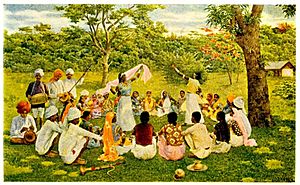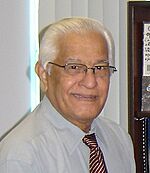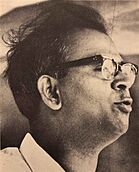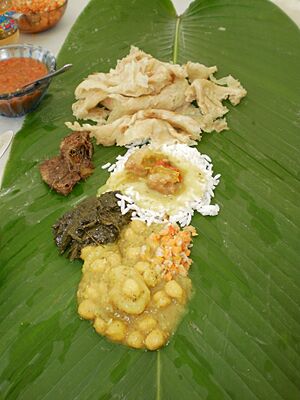Indo-Trinidadian and Tobagonian facts for kids

Painting of Indians in Trinidad during the late 19th century
|
|
| Total population | |
|---|---|
| 670,376 | |
| Regions with significant populations | |
(plurality of the population) |
|
| 125,000 | |
| 100,000 | |
| 25,000 | |
| Languages | |
| Trinidadian and Tobagonian English · Trinidadian Hindustani · Hinglish | |
| Religion | |
| Majority: Minority: |
|
| Related ethnic groups | |
| Indo-Caribbeans · Indo-Caribbean Americans · British Indo-Caribbean people · Indo-Guyanese · Indo-Surinamese · Indo-Jamaicans · Indo-Mauritians · Indo-Fijians · Indians in South Africa · Indian Singaporeans · Malaysian Indians · Indian people · Indian diaspora | |
Indo-Trinidadians and Tobagonians are people from Trinidad and Tobago whose families originally came from India. Their ancestors began arriving in 1845 during the time of colonization.
These people are part of a larger group called Indo-Caribbeans. Most Indo-Trinidadians can trace their family roots back to northern India, especially areas like Bhojpur and Awadh. Some also came from southern India.
The first Indians came to Trinidad and Tobago as indentured laborers between 1845 and 1917. This meant they worked under contract for a set period. Later, in the mid-20th century, more Indians and other South Asians came as businesspeople, doctors, and other professionals. Some also moved from other Caribbean islands like Guyana and Grenada.
Today, Indo-Trinidadians and Tobagonians are the largest ethnic group in Trinidad and Tobago. In 2011, they made up about 35.43% of the population.
Contents
A Look at Their History
Many Indian immigrants came to Trinidad between 1874 and 1917. Most of them were from areas in northern India, like the United Provinces of Agra and Oudh and Bihar. Smaller numbers came from other parts of British India, including Madras and Bengal.
These people often left India to escape poverty and find work. The British offered them jobs as indentured laborers or skilled workers. This demand for Indian workers grew a lot after slavery was ended in 1834. They were sent to plantations in the Caribbean and Africa to grow valuable crops like sugar.
Beliefs and Religions
Religious Makeup of Indo-Trinidadians (2011) Hinduism (49.54%) Christianity (25.27%) Islam (11.64%) Not Stated (6.3%) Other (5.87%) None (1.05%) Sikhism (0.06%)
According to the 2011 census, Hinduism is the most common religion among Indo-Trinidadians. About 49.54% of them are Hindu.
Other religions followed by Indo-Trinidadians include:
- Islam – 11.64%
- Pentecostalism/Evangelicalism/Full Gospel – 9.67%
- Roman Catholicism – 6.48%
- Presbyterianism/Congregationalism – 5.68%
- Other Christian groups – 7.73% (including Spiritual Baptist, Seventh-day Adventist Church, Jehovah's Witnesses, Anglicanism, Other Baptists, Methodism, Moravian Church)
- Trinidad Orisha – 0.31%
- Sikhism – 0.06%
- Rastafari – 0.02%
- Some people did not state their religion (6.30%) or said they had none (1.04%).
Hindus in Trinidad and Tobago belong to various groups. The largest is the Sanatan Dharma Maha Sabha. Other groups include SWAHA International and Arya Samaj.
Most Indo-Trinidadian Muslims are Sunni. There are also smaller groups of Shia and Ahmadiyya Muslims. The main Muslim organization is the Anjuman Sunnat-ul-Jamaat Association (ASJA).
The Sikh community has about 300 members. They are descendants of Punjabis who came long ago, and also more recent immigrants. They have a gurdwara (temple) in Tunapuna that was built in 1929.
In Politics
Indo-Trinidadians have often supported political parties that are not the People's National Movement (PNM). The PNM has often been seen as a party for African-Creole people.
Religion has also played a role in voting. For a while, Muslim and non-Presbyterian Christian Indo-Trinidadians supported the PNM. This was because the main Indo-Trinidadian parties, like the PDP and DLP, were seen as mostly Hindu and Presbyterian.
However, with newer parties like the NAR and the UNC, this religious divide has lessened. Still, the UNC often chooses a Muslim candidate for the San Juan/Barataria area because many Indo-Trinidadian Muslims live there.
Some important Indo-Trinidadian politicians include:
- Basdeo Panday – He was the first prime minister of Indo-Trinidadian descent. He was also the first Hindu to hold this high office.
- Kamla Persad-Bissesar – She was the first female prime minister of Trinidad and Tobago.
- Noor Mohamed Hassanali – He was the first Muslim head of state in the Western Hemisphere. He served as President of Trinidad and Tobago from 1987 to 1997.
- Christine Kangaloo – She is the first female president of Trinidad and Tobago of Indian descent.
- Rudranath Capildeo – He was the Leader of the opposition when Trinidad and Tobago became independent.
- Sarran Teelucksingh – He was the first Indian person elected to the Legislative Council in 1925. This council was a step towards today's Parliament.
- Isaac Hyatali – He was the first chief justice of Indo-Trinidadian descent.
- Satnarine Sharma – He was the first Hindu chief justice of Trinidad and Tobago.
Their Culture
Indo-Trinidadians and Tobagonians have kept their unique heritage and culture. They also live in a society with many different cultures. While many of their ancestors' languages are no longer spoken, some Indian words are now part of the local language.
Indian movies, music, and food are very popular in Trinidad and Tobago. Chutney and chutney soca music are even rivals to calypso and soca music during the Carnival season.
Holidays and Celebrations
Several holidays important to Indo-Trinidadians are national holidays in Trinidad and Tobago. These include Diwali, Eid ul-Fitr, and Indian Arrival Day.
Many other Hindu and Muslim holidays are also widely celebrated. These include Phagwah/Holi, Maha Shivratri, Hanuman Jayanti, Ram Naumi, Navratri, Vijayadashami, Krishna Janmashtami, Ramadan, Hosay (Ashura), and Eid al-Adha.
Delicious Food
Indo-Trinidadian and Tobagonian food comes mostly from northern India, with some influence from southern India. It has also been shaped by other cultures on the island, like Creole and Chinese. This local Indian food is different from the "mainstream" Indian food found in other parts of the world.
Breakfast Meals
A traditional Indo-Trinidadian breakfast often includes sada roti. This is a flatbread cooked on a special pan called a tawa. It's served with different fried vegetables or chokhas. Sometimes fried bake is eaten instead.
Breakfast dishes are usually vegetarian. They can include baigan chokha (mashed eggplant), aloo chokha (mashed potatoes), or pumpkin tarkari (pumpkin cooked with spices).
Popular Street Foods
Indo-Trinidadian foods like doubles, aloo pie, and pholourie are very popular street foods. They are served with different chutneys, achars, and pepper sauce.
Doubles is made with two pieces of fried dough called bara and curried channa (chickpeas). It's topped with things like pepper sauce and tamarind chutney. It's a favorite breakfast food, but people eat it all day long.
Another popular street food is roti. This is a wrap filled with curried vegetables, chicken, shrimp, or other spicy fillings. The town of Debe in southern Trinidad is famous for these street foods.
Festival Foods
For Diwali and other Hindu festivals, people eat special foods. Appetizers include pholourie and kachori. Main dishes often feature roti and karhi with rice. These are served with condiments like achar and pepper sauce.
Vegetable dishes include curried mango, bhaji (spinach), pumpkin, and curry channa and aloo. Desserts are also a big part of festivals. They include mohan bhog, burfi, khurma, gulab jamun, and jalebi. These are often served on a sohari leaf.
For Eid and Hosay, Muslim families prepare foods like curry goat, curry channa and aloo, and sweets such as sawine and burfi.
Condiments and Sauces

Indo-Trinidadians love to add various condiments to their meals. These often include homemade pepper sauces, chutneys, and pickles.
Pepper sauces are made with hot peppers, vinegar, and sometimes carrots or sour cherries. Mother-in-law is another popular spicy mix of peppers, pimentos, and carrots.
Chutneys are also common, made from fruits like mango, tamarind, and cucumber. They are great with street foods like doubles. There are also many types of pickles, known as achar or anchar. Kuchela, a spicy grated mango pickle, is very popular.
Sweets and Desserts
Indian sweets and desserts are very common in Trinidad and Tobago. They are often shared at Indian weddings and religious events.
Some popular sweets include kheer (sweet rice), sawine, khurma, gulab jamoon, burfi, laddu, jalebi, and halwa.
Dance and Music
Indian dance forms are very important to Indo-Trinidadians. Kathak, Odissi, and Bharatanatyam are popular classical dance forms. Indian folk dances and Bollywood dancing are also enjoyed.
Indian music, especially chutney and chutney soca, is a big part of the culture.
Theatre and Plays
Indian theatre is also popular. Plays like Raja Harishchandra and Bhakt Prahalad were brought by Indians. While some of these old plays are less common now, cultural groups are working to preserve them.
Ramleela, a play about the Hindu deity Rama, is very popular. It is performed around Diwali. The celebrations end with burning a large effigy of Ravana, the villain from the Ramayana. Rasleela (Krishnaleela), a play about the Hindu deity Krishna, is popular around Krishna Janmashtami.
Influence on Trinidad and Tobago
The Indian influence is very clear in Trinidad and Tobago. They are the largest ethnic group in the country. You can see mandirs (temples), masjids (mosques), and Hindu prayer flags (jhandis) everywhere. There are also many Indian schools, shops, and markets.
Many places in Trinidad and Tobago are named after Indian cities or people. Examples include Calcutta Settlement, Madras Settlement, Delhi Settlement, and Gandhi Village.
The holidays of Diwali, Eid al-Fitr, and Indian Arrival Day are national holidays. The Trinidadian Hindustani language has also influenced Trinidadian English. Many people of Indian descent speak a mix of Trinidadian English and Trinidadian Hindustani, using more Hindustani words than other groups.
Important People
See Also
- Chutney music
- Chutney soca
- History of Trinidad and Tobago
- Indian Arrival Day
- Indian indenture system
- Indo-Caribbean
- Indo-Caribbean music
- Indo-Guyanese
- Indo-Surinamese
- Pichakaree
- India–Trinidad and Tobago relations








